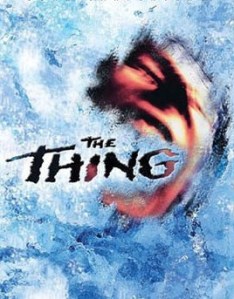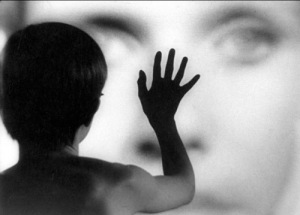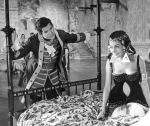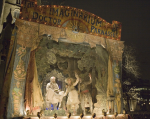Posts Tagged ‘Retrospective’
The Thing
 I already knew The Thing quite well, having screened it for my college film society, as part of a body-horror double bill. But some stimulating retrospective pieces in national papers whetted my appetite, and when I found it was showing at my local multiplex I couldn’t resist. It was the prospect of seeing that masterpiece on an enormous screen, with a presumably thin audience and all the privacy in the world that made it so, frankly, irresistible. One thing failed to disappoint – the film.
I already knew The Thing quite well, having screened it for my college film society, as part of a body-horror double bill. But some stimulating retrospective pieces in national papers whetted my appetite, and when I found it was showing at my local multiplex I couldn’t resist. It was the prospect of seeing that masterpiece on an enormous screen, with a presumably thin audience and all the privacy in the world that made it so, frankly, irresistible. One thing failed to disappoint – the film.
To my ambivalent surprise, I arrived to an officially sold-out screening. 10 left out of several hundred seats. This is fine, I thought – quite pleasing to see so great a turn out for a left-field rerun – perhaps a serious crowd of cult fanatics. Maybe we will see more of this sort of thing. Of course, I could no longer expect a comfortable space with aural insulation – but having seen The Thing before, surely I won’t be so tetchy about getting under the skin of the film – becoming immersed in the experience so I don’t miss a thing, so I respond in good tune.
I enter the theatre, having missed the opening shots of that remarkable first scene – a husky in flight from two helicopter-mounted Norwegians, letting rip with assault rifle and grenade. I stood aside and let the action subside before interrupting other virtuous filmgoers. Ah-hah! A perfect seat nestles half way up the stairs, at the middle of a row. Not too bad, I think, as I politely slip past the seated and sink into my chair. Then it begins to sink into me.
Elephant
Elephant is a film it took a while for me to get round to watching. It is also a film which I had hardly heard of, beyond the brief buzz around its Cannes prize winning. I did get round to watching it, and its poetry moved me to try describe it in some aspect.
 Like Russian Ark, it travels around its setting tracing a history, but this is a history in non-linear time, foreshadowing and backshadowing, rather than taking stock of a past. It follows ordinary people; we see them as an other, but we also trace their footsteps as though in their shoes, and we (as the camera, present as our eye) are not really seeing through a subject as in Russian Ark: there is no self, interpretation or discourse here. As if to underscore that fact the camera just flows through the halls, through the doorways, going where these people go, in absorbed, transparent coping, in basic understanding. And at the same time we are interpreting, we are conscious of a discourse by Van Sant on these people, in this place. Not only are we seeing (as them) how they effortlessly, unconsciously and intelligibly navigate their worlds, but we are also seeing them as subjects who are relating to the objects around them, (and so conjuring that intentional space in our own conceptual abstraction). And here is where Van Sant tells his story – a story which delves deeply into the observation of, first, Godard’s assertion that “les travellings sont affaire de morale” and more importantly, Luc Moullet’s primordial formulation, “la morale est affaire de travellings” – because these tracking shots are phenomenal manifestations of morality.
Like Russian Ark, it travels around its setting tracing a history, but this is a history in non-linear time, foreshadowing and backshadowing, rather than taking stock of a past. It follows ordinary people; we see them as an other, but we also trace their footsteps as though in their shoes, and we (as the camera, present as our eye) are not really seeing through a subject as in Russian Ark: there is no self, interpretation or discourse here. As if to underscore that fact the camera just flows through the halls, through the doorways, going where these people go, in absorbed, transparent coping, in basic understanding. And at the same time we are interpreting, we are conscious of a discourse by Van Sant on these people, in this place. Not only are we seeing (as them) how they effortlessly, unconsciously and intelligibly navigate their worlds, but we are also seeing them as subjects who are relating to the objects around them, (and so conjuring that intentional space in our own conceptual abstraction). And here is where Van Sant tells his story – a story which delves deeply into the observation of, first, Godard’s assertion that “les travellings sont affaire de morale” and more importantly, Luc Moullet’s primordial formulation, “la morale est affaire de travellings” – because these tracking shots are phenomenal manifestations of morality.
An essay on film as art (III)
Part III: Why ‘art’ cannot be defined in relation to conditions
So far, we have established several criteria which are neither individually necessary nor completely jointly sufficient conditions to classify a film as a work of art. Those films produced by an artist and presented to an artworld public, which exhibit representational, expressive and formal characteristics, and which were intended to have the capacity to satisfy the aesthetic interest, can be works of art. However, if art is to be defined in terms of individually necessary and jointly sufficient conditions, in lieu of such conditions, film cannot be described as an art form.
Dean argues that such conditions are not discoverable. Both cognitive science and (select) philosophy support the view that the structure of concepts mirrors the way humans categorize things: in respect to their similarity to prototypes, not in terms of necessary and sufficient conditions (Dean, ‘The Nature of Concepts and the Definition of Art’ in Journal of Aesthetics and Art Criticism 61). Against this it has been contended that such psychological theories of concepts afford, at best, an account of how people seem to classify things, but cannot account for the correct classification of extra-psychological phenomena; and that such theories are presently too controversial to draw substantive philosophical morals from. On the contrary, I urge that by mobilising certain philosophical arguments, the quest for a definition of art that states individually necessary and jointly sufficient conditions can be proven misguided. We do categorize things in respect to their similarity to prototypes. This is clear both from psychological theories of concepts and Berkeley’s subjective idealist analysis of general names. Therefore, if we are to determine whether film is or can be an art form, art should be defined in relation to prototypes, rather than by assembling conditions.
An essay on film as art (II)
Part II: Aesthetic definition
Beardsley argues that what defines an artwork is “the intention of giving it the capacity to satisfy the aesthetic interest” (Beardsley, ‘An Aesthetic Definition of Art’ in Lamarque and Olsen, p.58). Aestheticians refer to the most concentrated (complete, unified or intense) perceptions, and those which are controlled by the object experienced, as ‘aesthetic experiences’. ‘Aesthetic interest’ incorporates two ideas: the audience takes an interest in the aesthetic character of the experience they hope to gain from the work; and they have an interest in obtaining the experience, for its intrinsic value.
In discussing Persona and Cries and Whispers, several examples of film arousing aesthetic experience have been called to account. The beauty of Nykvist’s images in Persona is undeniable, as is the case in Cries and Whispers. In the former, novel techniques such as the merging of two faces further piques aesthetic interest. In the latter, we have seen that the audience has an interest in obtaining the aesthetic experience in the most literal sense – to fully make sense of the film and its search for the truth of the soul in suffering, one’s perceptions must be heightened to make the necessary representational connections. Sounds (whispers, screams, chimes, music) arouse the most acute of aesthetic experiences (though less so in Persona, where the soundtrack of dripping taps, ringing telephones and dissonant avant-garde orchestral music creates unease).
An essay on film as art (I)
In memory of Ingmar Bergman.
Part I: Traditional definitions
Traditional definitions of art, as portrayed in contemporary discourse, take artworks to be characterised by a single type of property. According to Thomas Adajian,
the standard candidates are representational properties, expressive properties and formal properties. So there are representational or mimetic definitions, expressive definitions, and formalist definitions, which hold that artworks are characterised by their possession of, respectively, representational, expressive and formal properties. (Adajian, ‘The Definition of Art’, p.2)
Each of these characteristics can apply to film. In fact, film often combines them simultaneously. However, traditional definitions do not necessarily apply to film in the same respect as they would to traditional art forms. Film frequently employs a complex interrelation of form, visual and aural, to convey expressive and representational elements. This is difficult for traditional, monistic definitions of art to account for. To explore the representational, expressivist and formalist properties which film exhibits we may turn to the specific example of Persona and Cries and Whispers, directed by Ingmar Bergman and shot by Sven Nykvist.
Representational properties
 In the opening sequence of Persona we are presented with a montage of starkly black and white images including an erect penis, a nail being driven through a hand, a sheep being slaughtered, several images of what appear to be corpses and finally a young boy reaching out to a blurred image of a female face. These are representational in several respects. Firstly, the events in the film’s narrative are echoed in the images on screen – the erect penis relating directly to Alma’s retelling of her orgy experience, the young boy reaching toward the face representing Alma’s hatred of and emotional disconnection towards her son. This is clearly self-reflective representation: an opening sequence which may be seen as a montage of metaphors for the themes about to be explored in the rest of the film. Secondly, this sequence represents the nature of subjective mental phenomena, particularly dreams. The disjointed, symbolic nature of the images coupled with their presentation in contrasting black and white lends an intensely oneiric quality to the sequence. The blurred faces to which the boy reaches out are a striking metaphor for Alma’s guilt concerning her feelings towards her son. The images of this sequence can be understood as from directly inside Alma’s mind. In fact, Bergman conceived of the blurring of the faces as he lay sick with pneumonia, and might well be presenting a representation of his own subjective and hallucinatory experiences. This is entirely plausible, particularly given the strong parallels between this sequence and those of archetypal surrealist cinema (Un Chien Andalou and Le Sang d’un Poète are both called to mind). Bergman also interrogates the nature of representation itself: the status of the image and the status of the filmic medium. Included in the montage are images of movie reels, projectors and broken film footage. The film presents a representation of itself breaking, another reflexive turn that refers to the internal states of the protagonists.
In the opening sequence of Persona we are presented with a montage of starkly black and white images including an erect penis, a nail being driven through a hand, a sheep being slaughtered, several images of what appear to be corpses and finally a young boy reaching out to a blurred image of a female face. These are representational in several respects. Firstly, the events in the film’s narrative are echoed in the images on screen – the erect penis relating directly to Alma’s retelling of her orgy experience, the young boy reaching toward the face representing Alma’s hatred of and emotional disconnection towards her son. This is clearly self-reflective representation: an opening sequence which may be seen as a montage of metaphors for the themes about to be explored in the rest of the film. Secondly, this sequence represents the nature of subjective mental phenomena, particularly dreams. The disjointed, symbolic nature of the images coupled with their presentation in contrasting black and white lends an intensely oneiric quality to the sequence. The blurred faces to which the boy reaches out are a striking metaphor for Alma’s guilt concerning her feelings towards her son. The images of this sequence can be understood as from directly inside Alma’s mind. In fact, Bergman conceived of the blurring of the faces as he lay sick with pneumonia, and might well be presenting a representation of his own subjective and hallucinatory experiences. This is entirely plausible, particularly given the strong parallels between this sequence and those of archetypal surrealist cinema (Un Chien Andalou and Le Sang d’un Poète are both called to mind). Bergman also interrogates the nature of representation itself: the status of the image and the status of the filmic medium. Included in the montage are images of movie reels, projectors and broken film footage. The film presents a representation of itself breaking, another reflexive turn that refers to the internal states of the protagonists.






